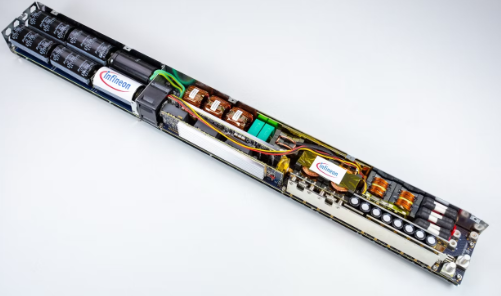Infineon Unveils 12 kW High-Performance Power Supply Reference Design for AI Data Centers and Servers
Release time:Sep 16, 2025
Views:76

Munich, Germany – Infineon Technologies AG (FSE: IFX / OTCQX: IFNNY) has introduced a new 12 kW high-performance power supply (PSU) reference design optimized for artificial intelligence (AI) data centers and server applications. This solution delivers exceptional efficiency and power density while leveraging the full range of advanced semiconductor materials: silicon (Si), silicon carbide (SiC), and gallium nitride (GaN). It is specifically aimed at power electronics engineers, hardware designers, and system developers.
“As AI drives unprecedented demand for energy, Infineon’s role is to enable the highest levels of power conversion efficiency—saving every watt possible,” said Richard Kunčič, Senior Vice President and General Manager of Power Switches at Infineon. “Our new 12 kW reference design, built with advanced topologies and powered by CoolMOS™, CoolSiC™, and CoolGaN™ technologies, pushes the boundaries of energy efficiency, reliability, and power density. We are proud to be shaping the future of AI-powered infrastructure.”
To achieve this performance, the design implements state-of-the-art AC/DC and DC/DC conversion stages. The AC/DC front end features a three-level flying capacitor interleaved power factor correction (PFC) topology, delivering peak efficiency above 99.0% while reducing magnetic component size—enabled by Infineon’s CoolSiC technology, known for superior switching speed and thermal performance. The isolated DC/DC stage adopts a full-bridge LLC resonant converter, reaching peak efficiency above 98.5% through the use of dual planar high-frequency transformers and Infineon’s CoolGaN devices. Combined, these architectures and wide-bandgap technologies achieve a power density of up to 113 W/in³.
Another key highlight is the integrated bidirectional energy buffer, which not only meets system hold-up time requirements but also reduces overall capacitance needs. Additionally, it provides grid-shaping functionality, improving system reliability and mitigating power fluctuations and slew rates during transient events.

FIND US
UNIT2223,22/F YAN'S TOWER 25 - 27 WONG CHUK HANG RD
ABERDEEN HONG KONG
POLICIES Quality & Certifications
Privacy Policy
Privacy Policy
RESOURCES Product Categories
Manufacturers
News & Articles
Tags
Manufacturers
News & Articles
Tags
SERVICES Send RFQ
Contact Us
Contact Us
QUICK INQUIRY Send the product number you need at any time, we will give you the first time accurate reply  Submit RFQ
Submit RFQ
 Submit RFQ
Submit RFQ © 2025 SUNETHER TECHNOLOGY LIMITED. All rights reserved.




